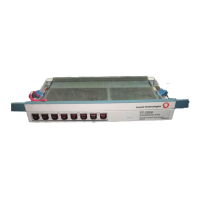Administration and Provisioning
Issue 8.0 July 2002
8-35
The 1-way-DRI cross-connections are also made from any service low-speed
interface slot and the companion low-speed interface slot (for example, 2A and
2B) when the slot pair is provisioned for the OC-3 1+1 protected mode. (Any
low-speed port associated with the slot pair may be specified when entering the
cross-connection.)
A single input enters an active and standby add cross-connection from the service
low-speed interface slot pair to a service STS-3 tributary and a standby through
cross-connection for the same STS-3 tributary.
The active add cross-connection carries traffic during normal conditions. If an
incoming DS3 or EC-1 loss-of-signal condition is detected by the low-speed
interface circuit pack, the through cross-connection becomes active and the add
cross-connection becomes standby. An unprotected incoming OC-3 loss-of-signal
or loss-of-frame condition also causes the through cross-connection to become
active and the add cross-connection to become standby.
For Release 7.0 and prior releases, after the LOS, LOP, LOF or Line AIS condition
clears, traffic does not automatically switch (revert) to the add cross-connection. A
reset must be performed using the FAULT-Switch-Path-STS1 input to switch the
traffic back to the add cross-connection.
Release 7.1.0 and later releases provide revertive DRI and do automatically
switch back to the service fiber.
For more information about the dual ring interworking (DRI) application, refer to
Volume I, Section 2, "Applications." For more information about DRI protection
switching, refer to Volume I, Section 9, "Maintenance Description."

